 Petzlover
PetzloverBoth Black and Tan Terrier and Flat-Coated Retriever are originated from United Kingdom. Black and Tan Terrier may grow 23 cm / 9 inches shorter than Flat-Coated Retriever. Black and Tan Terrier may weigh 25 kg / 55 pounds lesser than Flat-Coated Retriever. Black and Tan Terrier may live 3 years more than Flat-Coated Retriever. Both Black and Tan Terrier and Flat-Coated Retriever has same litter size. Both Black and Tan Terrier and Flat-Coated Retriever requires Moderate Maintenance.
There is limited information on the Black and Tan Terriers since it is extinct. Black and Tan terrier came out of the “Terrier Wars” between the British and the Welsh in the late 1800’s. With dog shows on the rise, a race began to develop terriers that “belonged” to the Welsh or the British. The Black and Tan Terrier started out as the “Old English Broken-Haired Black and Tan”. The outrages Welsh responded with their first dog show filled with Welsh only terriers. There were 90 dogs at this first show. During this time, the British could not get their act together in respect to starting a club. Even agreeing on the name was difficult for them. Unfortunately, the dogs from both countries were not truly a “breed” but rather first-generation crosses between a wide variety of terriers. These terriers included breeds such as the Lakeland Terrier, the Welsh Terrier, the Patterdale Terrier, Fell Terriers, Border Terrier, Scottish Borders and the Manchester Terrier. The winner of that first dog show was a terrier cross between a Smooth Fox Terrier and a Border Terrier.
In 1885 both the Welsh and the British Black and Tan Terrier were featured. However, the English could not get the club together, so they were dropped from the Kennel Club Listings and only the Welsh Terrier was offered. The Black and Tan Terrier became extinct before 1900.
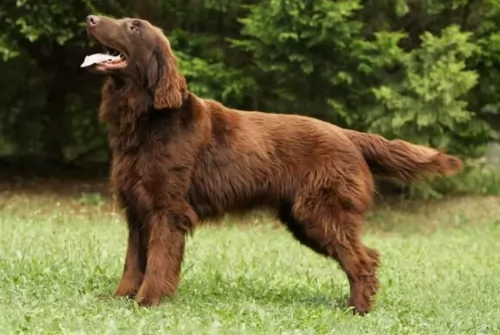 The Flat-Coated Retriever traces its heritage to 19th century England. A popular gamekeepers’ dog, the actual descendants of the breed are not entirely known. Like so many well-established breeds, there are many lines of thought about the breed line. There is an unverified line of ancestry that includes the St. Johns Water Dog – an extinct breed from North America. Another story has Canadian sailors bringing their Newfoundlands to England and mixing them with Colliers and Setters. This story has more truth to it and it took 20 years to establish the final breed type.
The Flat-Coated Retriever traces its heritage to 19th century England. A popular gamekeepers’ dog, the actual descendants of the breed are not entirely known. Like so many well-established breeds, there are many lines of thought about the breed line. There is an unverified line of ancestry that includes the St. Johns Water Dog – an extinct breed from North America. Another story has Canadian sailors bringing their Newfoundlands to England and mixing them with Colliers and Setters. This story has more truth to it and it took 20 years to establish the final breed type.
The breed was originally a retriever with two purposes – to retrieve the hunters’ bounty on land and on water.
The Flat-Coated Retriever was then introduced to the United States as a gun dog. By 1873 it was a “stable type” and in 1915 the AKC recognized the breed. After this, their popularity grew quickly until the American public fell in love with the Golden Retriever and the Labrador Retriever. Then the Flat-Coated Retriever’s numbers and popularity fell. The irony was that both the Golden and the Labrador credited the Flat-Coated Retriever as an ancestor. The survival of the breed was questionable following World War Two. They were brought back by a specific breeding program in the 1960’s.
Breeders in the ‘60s made sure they bred for both show dogs and companion animals. The Flat-Coated Retriever survived and is less popular than other retrievers, but he has his fans. The breed is more popular in the United Kingdom than it is in the United States in part because of Best in Show wins at Crufts
The Black and Tan Terrier was an active, alert dog. A ratter as most terriers are. With a sleek coat, tan markings and thumbing, he was a handsome dog. Looks very much like the other terriers of his size and color with a truncated tail. He had small erect ears and a snout that was moderately elongated.
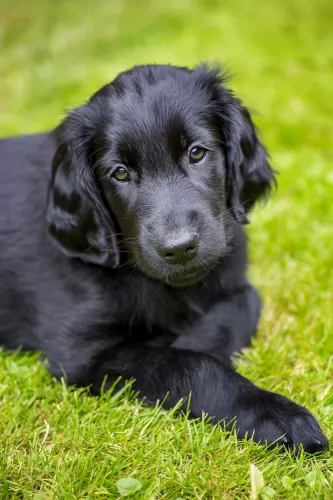 The Flat-Coated Retriever has a straight and strong topline with unique head, strong jaws, a long muzzle and small ears. His eyes are dark brown almonds with a friendly and intelligent expression. He has an arched neck and a moderately long tail. The Flat-Coated Retriever is more of an athlete, lighter and certainly more elegant than any other type or breed of retriever.
The Flat-Coated Retriever has a straight and strong topline with unique head, strong jaws, a long muzzle and small ears. His eyes are dark brown almonds with a friendly and intelligent expression. He has an arched neck and a moderately long tail. The Flat-Coated Retriever is more of an athlete, lighter and certainly more elegant than any other type or breed of retriever.
He was an alert and active dog. He was a good guard dog, an excellent ratter and a great family dog. He was affectionate, warm and gentle of the most alert and active of dogs, as game as a pebble, an ideal watchman, an unexcelled ratter and all done up in a small package. No dog exceeds him in beauty of outline, and this is enhanced by his sleek coat, with its sheen that the costliest satin does not possess; set off by the rich Tan markings, dainty penciling and thumbing that would puzzle an artist to reproduce. Information is limited on this extinct breed.
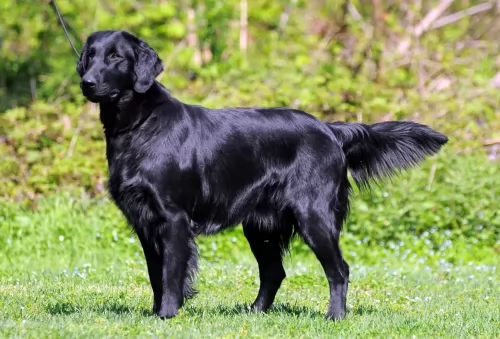 The Flat-Coated Retriever is great with children. Just be careful they don’t knock over small children in their enthusiasm.
The Flat-Coated Retriever is great with children. Just be careful they don’t knock over small children in their enthusiasm.
They are confident great family dogs. They are “thinking dogs” and need something to work for or they will work for themselves. They can be clowns.
They are adaptable although their size might preclude small locations without yards.
Smart, thinking all the time, they are very trainable. However, they are considered the “Peter Pan” of dogs – they never grow up.
The Black and Tan Terrier suffered from similar ailments as all terriers. He dealt with patella luxation (kneepads floating), skin allergies and eye issues. Because the breed is extinct there is little if any research on the health issues they might have experience before distinction
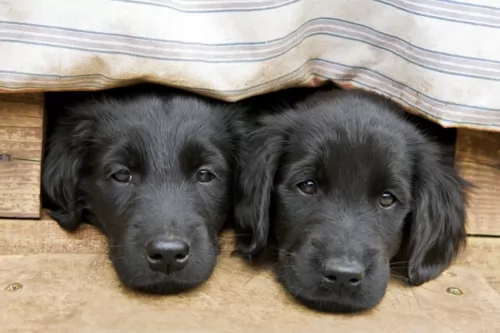 Flat-Coated Retrievers have their share of health concerns from dysplasia to cancer. The breeds problems include:
Flat-Coated Retrievers have their share of health concerns from dysplasia to cancer. The breeds problems include:
Hemangiosarcoma, Osteosarcoma, Malignant Histiocytosis, and Fibrosarcoma. Studies show that about half of all Flat-Coated Retrievers die of cancer.
As you would with any terrier of his size 1-2 cups day.
The Black and Tan Terrier suffered from similar ailments as all terriers. He dealt with patella luxation (kneepads floating), skin allergies and eye issues.
The Black and Tan Terrier is in fact a terrier. He was a ratter and he needed intelligent exercise to keep him happy and non-destructive. Activities like barn hunt, agility and fly ball are perfect for this breed. A walk a couple times a day with a time for games is what was needed, and he would love to play ball with kids. They were very cuddly dogs as well.
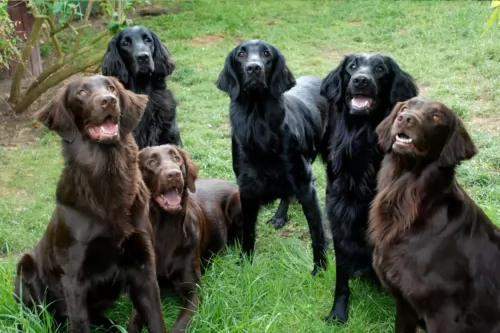 He will be a medium size dog. Feed puppies 3-4 times a day about a 1/8 cup of high-quality food. Feed a puppy food designed for medium size dogs or specifically for retrievers.
He will be a medium size dog. Feed puppies 3-4 times a day about a 1/8 cup of high-quality food. Feed a puppy food designed for medium size dogs or specifically for retrievers.
Feed 2 times a day about !/2 cups of dry food per meal. Do not overfeed. They have a tendency to be obese.
Maintain a healthy weight and avoid exercise before and after meals. The good news is dysplasia and epilepsy are rare in the breed.
They are very energetic and need good exercise. Long walks and a yard to run in. Remember they are hunting dogs and will chase to retrieve things so don’t let them off leash outside your yard. They will excel at agility, tracking. Rally, obedience, swimming, hunting, and jogging. They make great therapy dogs.